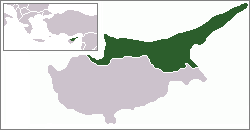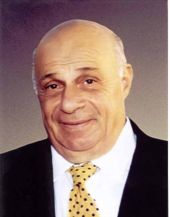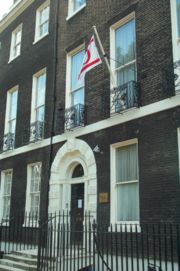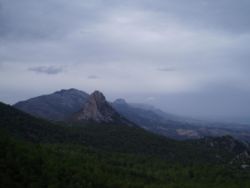Northern Cyprus
2008/9 Schools Wikipedia Selection. Related subjects: Europe; European Countries
| Kuzey Kıbrıs Türk Cumhuriyeti Turkish Republic of Northern Cyprus
|
||||||
|---|---|---|---|---|---|---|
|
||||||
| Anthem: İstiklâl Marşı ( Turkish) Independence March |
||||||
|
|
||||||
| Capital | Nicosia (Lefkoşa in Turkish) |
|||||
| Official languages | Turkish | |||||
| Government | Representative democratic republic1 | |||||
| - | President | Mehmet Ali Talat | ||||
| - | Prime Minister | Ferdi Sabit Soyer | ||||
| Independence ( de facto) | from Cyprus | |||||
| - | Proclaimed | November 15, 1983 | ||||
| - | Recognition | By Turkey only | ||||
| Area | ||||||
| - | Total | 3,355 km² ( 167th ranked together with Cyprus) 1,295 sq mi |
||||
| - | Water (%) | 2.7 | ||||
| Population | ||||||
| - | 20062 census | 264,172 | ||||
| - | Density | 78/km² ( 89th) 203/sq mi |
||||
| GDP ( PPP) | 2007 estimate | |||||
| - | Total | $4.54 billion ( 90th) | ||||
| - | Per capita | $7,135 ( 93rd) | ||||
| Currency | New Turkish lira ( YTL ( TRY reserved )) |
|||||
| Time zone | EET ( UTC+2) | |||||
| - | Summer ( DST) | EEST ( UTC+3) | ||||
| Internet TLD | .nc.tr, or .tr | |||||
| Calling code | +90 spec. +90-392 | |||||
| 1 | Freedomhouse.org Country Report | |||||
| 2 | The press statement of Prime Minister Ferdi Sabit Soyer on the tentative results of 2006 population and housing census (5 May 2006) PDF (88.8 KiB) Nüfus ve Konut Sayimi. | |||||
The Turkish Republic of Northern Cyprus (TRNC) ( Turkish: Kuzey Kıbrıs Türk Cumhuriyeti, KKTC), commonly called Northern Cyprus ( Turkish: Kuzey Kıbrıs), is a de facto independent republic located in the north of Cyprus. Officially this part of the Republic of Cyprus is under illegal Turkish occupation. The TRNC declared its independence in 1983, nine years after a Greek Cypriot coup attempting to annex the island to Greece triggered an invasion by Turkey. It has received diplomatic recognition only from Turkey, on which it has become dependent for economic, political and military support. The rest of the international community, including the United Nations and European Union, recognises the sovereignty of the Republic of Cyprus over the entire island, including the portion currently under the control of the TRNC.
The Turkish Army maintains a large force in the TRNC that meets with the approval of much of the Turkish Cypriot population. However, the Republic of Cyprus regards it as an illegal occupation force; its presence has also been denounced in several United Nations Security Council resolutions. Attempts to reach a solution to the dispute have so far been unsuccessful. In a 2004 referendum held simultaneously in both parts of the island, the UN Annan Plan to reunite the island was accepted by a majority of Turkish Cypriots. However, amidst concerns that the plan would eliminate the concept of one-person, one-vote largely in favour of Turkish Cypriots and would not safeguard Greek Cypriot rights in Northern Cyprus, an overwhelming majority of Greek Cypriots rejected the proposal.
The TRNC extends from the tip of the Karpass Peninsula ( Cape Apostolos Andreas) in the northeast, westward to Morphou Bay and Cape Kormakitis (the Kokkina/Erenköy exclave marks the westernmost extent of the TRNC), and southward to the village of Louroujina/Akıncılar. The no man's land or buffer zone stretching between the two areas is under the control of the United Nations.
History
The Constitution of Cyprus, while establishing an independent and sovereign republic, was, in the words of Stanley Alexander de Smith, an authority on constitutional law, "unique in its tortuous complexity and in the multiplicity of the safeguards that it provides for the principal minority; the Constitution of Cyprus stands alone among the constitutions of the world." Within three years, tensions between the two communities in administrative affairs began to show. In particular, disputes over separate municipalities and taxation created a deadlock in government. In 1963 President Makarios proposed unilateral changes to the constitution via thirteen amendments, which some observers viewed as an unconstitutional attempt to tilt the balance of power in the Republic. Turkey and the Turkish Cypriots rejected the proposed amendments as an attempt to settle constitutional disputes in favour of the Greek Cypriots and as a means of demoting the Turks' status as co-founders of the state to one of minority status, removing their constitutional safeguards in the process. The President defended his amendments as being necessary "to resolve constitutional deadlocks."
On 21 December 1963, a Turkish Cypriot crowd clashed with the plainclothes special constables of Yorgadjis. Almost immediately, intercommunal violence broke out with a major Greek Cypriot paramilitary attack upon Turkish Cypriots in Nicosia and Larnaca. Though the TMT — a Turkish resistance group created in 1959 to promote a policy of taksim (division or partition of Cyprus), in opposition to the Greek Cypriot nationalist group EOKA and its advocacy of enosis (union of Cyprus with Greece) — committed a number of acts of retaliation, historian of the Cyprus conflict Keith Kyle noted that "there is no doubt that the main victims of the numerous incidents that took place during the next few months were Turks." Seven hundred Turkish hostages, including women and children, were taken from the northern suburbs of Nicosia. Nikos Sampson, a nationalist and future coup leader, led a group of Greek Cypriot irregulars into the mixed suburb of Omorphita and attacked the Turkish Cypriot population. By 1964, 193 Turkish Cypriots and 133 Greek Cypriots had been killed, with a further 209 Turks and 41 Greeks missing and presumed dead.
Turkish Cypriot members of the government had by now withdrawn, creating an essentially Greek Cypriot administration in control of all institutions of the state. Widespread looting of Turkish Cypriot villages prompted 20,000 refugees to retreat into armed enclaves, where they remained for the next 11 years, relying on food and medical supplies from Turkey to survive. Turkish Cypriots formed paramilitary groups to defend the enclaves, leading to a gradual division of the island's communities into two hostile camps. The violence had also seen thousands of Turkish Cypriots attempt to escape the violence by emigrating to Britain, Australia and Turkey.
The Republic of Cyprus has argued that the Turkish Cypriots' withdrawal from the government and their retreat into enclaves was a voluntary action, prompted by their desire to form a state of their own. In support of this view, a 1965 statement has been cited in which the then– United Nations Secretary General, U Thant, stated that Turkish Cypriots had furthered a policy of "self-segregation" and taken a "rigid stand" against policies which might have involved recognizing the government's authority. Turkish Cypriots, for their part, point to a ruling of Cyprus's Supreme Court which found that Makarios had violated the constitution by failing to fully implement its measures and that Turkish Cypriots had not been allowed to return to their positions in government without first accepting the proposed constitutional amendments.
On July 15, 1974, the Greek military junta of 1967-1974 backed a Greek Cypriot military coup d'état in Cyprus. President Makarios was removed from office and Nikos Sampson took his place. Turkey claimed that, under the 1960 Treaty of Guarantee, the coup was sufficient reason for military action to protect the Turkish Cypriot populace, and thus Turkey invaded Cyprus on July 20, 1974. Following Turkey's military intervention, the coup failed and Makarios returned to Cyprus. Turkish forces proceeded to take over the northern third of the island (about 37% of Cyprus's total area), causing large numbers of Greek Cypriots to abandon their homes. Approximately 160,000 Greek Cypriots fled to the south of the island, while 50,000 Turkish Cypriots fled north. Approximately 1,500 Greek Cypriot and 500 Turkish Cypriots remain missing.
In 1975 the "Turkish Federative State of Cyprus" (Kıbrıs Türk Federe Devleti) was declared as a first step towards a future federated Cypriot state, but was rejected by the Republic of Cyprus, the UN, and the international community. After eight years of failed negotiations with the leadership of the Greek Cypriot community, the north declared its independence on November 15, 1983 under the name of the Turkish Republic of Northern Cyprus. This unilateral declaration of independence was rejected by the UN and the Republic of Cyprus.
In recent years the politics of reunification has dominated the island's affairs. It was hoped that Cyprus's planned accession into the European Union would act as a catalyst towards a settlement, and in 2004 a United Nations–brokered peace settlement was presented in a referendum to both sides. The proposed settlement was opposed by both the president of Cyprus, Tassos Papadopoulos, and Turkish Cypriot president Rauf Denktaş; in the referendum, a majority of Turkish Cypriots accepted the proposal, but Greek Cypriots overwhelmingly rejected it. As a result, Cyprus entered the European Union as a divided island, with the north (TRNC) effectively excluded. Denktaş resigned in the wake of the vote, ushering in the pro-solutionist Mehmet Ali Talat as his successor.
Government and politics
Politics of the Turkish Republic of Northern Cyprus takes place in a framework of a semi-presidential representative democratic republic, whereby the President is head of state and the Prime Minister head of government, and of a multi-party system. Executive power is exercised by the government. Legislative power is vested in both the government and the Assembly of the Republic. The Judiciary is independent of the executive and the legislature.
The president is elected for a five-year term. The current president is Mehmet Ali Talat who won the presidential elections on April 17, 2005. The legislature is the Assembly of the Republic, which has 50 members elected by proportional representation from five electoral districts. In the elections of February 2005, the Republican Turkish Party, which favors a peace settlement and the reunification of Cyprus , retained its position as the largest parliamentary party, but failed to win an overall majority.
International status and foreign relations
The international community, with the exception of Turkey, does not recognise the TRNC as a sovereign state, but recognises the de jure sovereignty of the Republic of Cyprus over the whole island. The United Nations considers the declaration of independence by the TRNC as legally invalid in several of its resolutions.
In wake of the April 2004 referendum on the United Nations Annan Plan, and the support of the Turkish Cypriot community for the plan, the European Union made pledges towards ending the isolation of northern Cyprus. These included measures for trade and 259 million euros in aid.
The Organization of the Islamic Conference gave the TRNC the status of a constituent state, making the "Turkish Cypriot State" an observer member of the organization. A number of high profile formal meetings have also taken place between President Mehmet Ali Talat and various foreign leaders and politicians including US Secretary of State Condoleezza Rice, British foreign minister Jack Straw, Pakistani President Pervez Musharraf.
The European Union considers the area not under effective control of the Republic of Cyprus as EU territory under Turkish military occupation and thus indefinitely exempt from EU legislation until a settlement has been found. The status of TRNC has become a recurrent issue especially during the recent talks for Turkey's membership of the EU where the division of the island is seen as a major stumbling block in Turkey's long road to membership.
On February 18, 2008, The TRNC became one of the first nations to acknowledge the Unilateral Declaration of Independence of the Republic of Kosovo, in direct opposition to the stance of the Republic of Cyprus, which rejects the Kosovo UDI. It is argued by the Turkish and TRNC media that the independence of Kosovo could be a good model for the TRNC's recognition. It is to be stressed however that the TRNC's government has not yet formally recognized the government of Kosovo, despite President Talat's message of congratulations to Kosovo.
Military
The Turkish Republic of Northern Cyprus has an indigenous 5,000-man Turkish Cypriot Security Force (TCSF), which is primarily made up of conscripted Turkish Cypriot males between the ages of 18 and 40. There is also an additional reserve force consisting of about 11,000 first-line, 10,000 second-line and 5,000 third-line troops conscripted up to the age of 50. The TCSF is lightly armed and heavily dependent on its mainland Turkish allies, from which it draws much of its officer corps. It is led by a Brigadier General drawn from the Turkish Army. It acts essentially as a gendarmerie with a self-proclaimed mission of protecting the border of the TRNC from Greek Cypriot incursions and maintaining internal security within the TRNC.
In addition, the mainland Turkish Armed Forces maintain a Cyprus Turkish Peace Force (CTPF) consisting of around 30-40,000 troops drawn from the 9th Turkish Army Corps and comprising two divisions, the 28th and 39th. It is equipped with a substantial number of United States-made M48 Patton main battle tanks and artillery weapons. The Turkish Air Force, Turkish Navy and Turkish Coast Guard also have a presence in Northern Cyprus. Although formally part of Turkish 4th Army, headquartered in İzmir, the sensitivities of the Cyprus situation means that the commander of the CTPF also reports directly to the Turkish General Staff in Ankara. The CTPF is deployed principally along the Green Line and in locations where hostile amphibious landings might take place.
The presence of the mainland Turkish military in Cyprus is highly controversial, having been denounced as an illegal occupation force by the Republic of Cyprus government. Several United Nations Security Council resolutions have called on the Turkish forces to withdraw, though failed Annan Plan of 2004 allowed for some troops to remain.
Administrative divisions
The Turkish Republic of Northern Cyprus is divided into five administrative regions:
- Lefkoşa (Nicosia)
- Mağusa (Famagusta)
- Girne (Kyrenia)
- Güzelyurt (Morphou)
- İskele (Trikomo)
Geography and climate
The climate of the island is of an extreme Mediterranean type with very hot dry summers and relatively cold winters. Most of the rainfall is concentrated between December and January.
The climate of the coastal parts is less extreme than farther inland, due to the fact that the effect of the sea on atmospheric humidities is always present there. The sea temperature itself never falls below 16°C. (January and February); in August it can rise to 28 °C.
Spring and autumn are short, typified by changeable weather, with occasional heavy storms battering the coast in spring and a westerly wind, called "meltem" carrying the influence of Atlantic depressions to this far eastern end of the Mediterranean.
From mid-May to mid-September the sun shines on a daily average of around 11 hours. Temperatures can reach 40°C. On the Mesaoria Plain, although lower on the coasts, a north-westerly breeze called "Poyraz" prevails. The skies are cloudless with a low humidity, 40% - 60%, thus the high temperatures are easier to bear. The hot, dry, dust-laden sirocco wind blowing from Africa also finds its way to the island.
Short-lived stormy conditions resulting from fairly frequent small depressions prevail throughout the winter, with 60% of rain falling between December and February. The Northern Range receives around 550 mm of rain per year, whereas the Mesaoria Plain receives only around 300-400 mm.
Frost and snow are almost unknown in Northern Cyprus, although night temperatures can fall to very low levels in winter and it will occasionally snow on the peaks of the Kyrenia Range.
The chief rain-bearing air currents reach the island from the south-west, so that precipitation and atmospheric humidity is at its greatest on the western and south-western sides of the Southern Range. Eastwards, precipitation and humidity are reduced by the partial rain-shadow effect of the Southern Range, a similar effect is also caused by the Northern Range which cut off the humidity associated with proximity to the sea from much of the northern Mesaoria Plain. Eastwards of the Northern Range, towards the bays of the Karpaz Peninsula, where the land narrows and the effect of sea influence increases accordingly, humidity increases progressively towards the end of the peninsula.
Most of the rivers are simply winter torrents, only flowing after heavy rain, the rivers running out of the Northern and Southern Ranges rarely flowing all the year round.
During the wet winter months Cyprus is a green island. However, by the time June arrives the landscape at the lower levels assumes the brown, parched aspect which characterises its summer face. The forests and the vineyards in the mountains, plus the strips of irrigated vegetation in the valleys remain green.
Economy
The economy of the Turkish Republic of Northern Cyprus is dominated by the services sector including the public sector, trade, tourism and education, with smaller agriculture and light manufacturing sectors. The economy operates on a free-market basis, with a great portion funding of the administration costs offered by Turkey.
Because of its status and the embargo, the TRNC is heavily dependent on Turkish military and economic support. It uses the New Turkish Lira as its currency; this used to link its economic status to the vagaries of the Turkish economy. All TRNC exports and imports have to take place via Turkey, unless they are produced locally, from materials sourced in the area (or imported via one of the island's recognised ports) when they may be exported via one of the legal ports.
The continuing Cyprus problem adversely affects the economic development of the TRNC. The Republic of Cyprus, as the internationally recognised authority, has declared airports and ports in the area not under its effective control, closed. All U.N. Member countries and E.U. member countries respect the closure of those ports and airports according to the declaration of the Republic of Cyprus. The Turkish community argues that the Republic of Cyprus has used its international standing to handicap economic relations between TRNC and the rest of the world.
Despite the constraints imposed by its lack of international recognition, the TRNC economy turned in an impressive performance in the last few years. The GDP growth rates of the TRNC economy in 2001-2005 have been 5.4%, 6.9%, 11.4%, 15.4% and 10.6%. This growth has been buoyed by the relative stability of the Turkish Lira and a boom in the education and construction sectors.
Studies by the World Bank show that the per capita GDP in TRNC grew to 76% of the per capita GDP in the Republic of Cyprus in PPP-adjusted terms in 2004. (USD 22,300 for the Republic of Cyprus and USD 16,900 for the TRNC).
Although the TRNC economy has developed in recent years, it is still dependent on monetary transfers from the Turkish government. Under the 2003-06 economic protocol, Ankara plans to provide around $550 million to the TRNC.
The number of tourists visiting Turkish Republic of Northern Cyprus during January-August 2003 was 286,901.
The Turkish Cypriot economy has also benefited from an abundance of universities including Near East University, Girne American University, Middle East Technical University, European University of Lefke and Cyprus International University as well as Eastern Mediterranean University which is internationally recognised with more than 1000 faculty members coming from 35 countries. There are 15000 students in the university comprised of 68 different nationalities. EMU has been approved by Higher Education Council of Turkey. It is full individual member of the institutions like the European University Associations, Community of Mediterranean Universities, Federation Universities of Islamic World And International Association of Universities.
Communications and transport
International telephone calls are routed via a Cyprus or Turkish dialling code: +90 392, as the TRNC has neither its own country code, nor official ITU prefix. Similarly, the TRNC has no top level domain of its own, and is under the Turkish second-level domain .nc.tr, while mail must be addressed 'via Mersin 10, TURKEY' as the Universal Postal Union does not recognise the TRNC as a separate entity. Amateur radio operators sometimes use callsigns beginning with "1B", but these have no standing for awards or other operating credit.
Direct flights to Turkish Republic of Northern Cyprus and the trade traffic through the Turkish Cypriot ports are restricted as part of the embargo on Turkish Cypriot ports. The airports of Geçitkale and Ercan are only recognised as legal ports of entry by Turkey and Azerbaijan. In addition, the TRNC's seaports in Famagusta and Kyrenia had been declared closed to all shipping by the Republic of Cyprus since 1974. By agreement between northern Cyprus and Syria, despite the protests of the Republic of Cyprus,there is a ship tour between Famagusta and Latakia (Syria). Since the opening of the Green Line, Turkish Cypriot residents are allowed to trade through Greek Cypriot ports.
Naturalised TRNC citizens or foreigners carrying a passport stamped by the TRNC authorities may be refused entry by the Republic of Cyprus or Greece, although after the accession of the Republic of Cyprus to the EU such restrictions have been eased following confidence-building measures between Athens and Ankara and the partial opening of the UN controlled line by the Turkish Republic of Northern Cyprus authorities. The Republic of Cyprus also allows passage across the Green Line from the part of Nicosia that it controls (as well as a few other selected crossing points), since the TRNC does not leave entry stamps in the passport for such visits. Since May 2004, some tourists have taken to flying to the Republic of Cyprus directly and crossing the green line to holiday in the TRNC.
Demographics
According to a census carried out by the Turkish Cypriot administration, the TRNC has a population of about 264,172, of which majority is composed of indigenous Turkish Cypriots, with the rest including a large number of settlers from Turkey. Of the 178,000 Turkish Cypriot citizens, 74% are native Cypriots (approximately 140,000). Of the remaining people born to non-Cypriot parentage, approximately 16,000 were born in Cyprus. The figure for non-citizens, including students, guest workers and temporary residents stood at 78,000 people. Estimates by the government of the Republic of Cyprus from 2001 place the population at 200,000, of which 80-89,000 are Turkish Cypriots and 109,000-117,000 Turkish settlers.. An island-wide census in 1960 indicated the number of Turkish Cypriots as 102,000 and Greek Cypriots as 450,000. Estimates state that 36,000 (about 1/3) Turkish Cypriots emigrated in the period 1975-1995, with the consequence that within the occupied area the native Turkish Cypriots have been outnumbered by settlers from Turkey. The TRNC is almost entirely Turkish speaking. English, however, is widely spoken as a second language. Many of the older Turkish Cypriots speak and understand Greek - some may even be considered native speakers of the Greek Cypriot dialect.
There are small populations of Greek Cypriots and Maronites (about 3,000) living in Rizokarpaso and Kormakitis regions.







